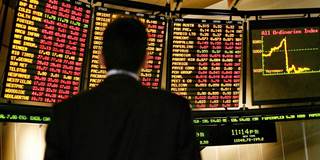Over the course of the past decade, the global economy has recovered from the 2008 financial crisis by riding a wave of debt and liquidity injections from the major central banks. Yet in the absence of steady wage growth and productive investments in the real economy, the only direction left to go is down.
GENEVA – When Lehman Brothers declared bankruptcy ten years ago, it suddenly became unclear who owed what to whom, who couldn’t pay their debts, and who would go down next. The result was that interbank credit markets froze, Wall Street panicked, and businesses went under, not just in the United States but around the world. With politicians struggling to respond to the crisis, economic pundits were left wondering whether the “Great Moderation” of low business-cycle volatility since the 1980s was turning into another Great Depression.

GENEVA – When Lehman Brothers declared bankruptcy ten years ago, it suddenly became unclear who owed what to whom, who couldn’t pay their debts, and who would go down next. The result was that interbank credit markets froze, Wall Street panicked, and businesses went under, not just in the United States but around the world. With politicians struggling to respond to the crisis, economic pundits were left wondering whether the “Great Moderation” of low business-cycle volatility since the 1980s was turning into another Great Depression.